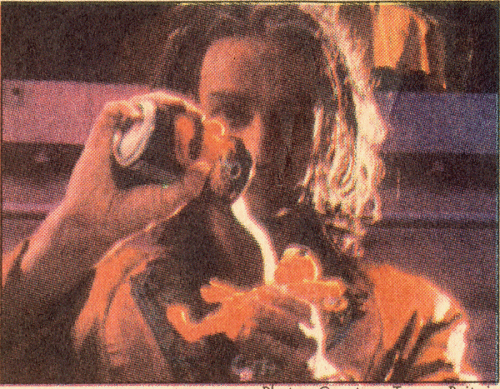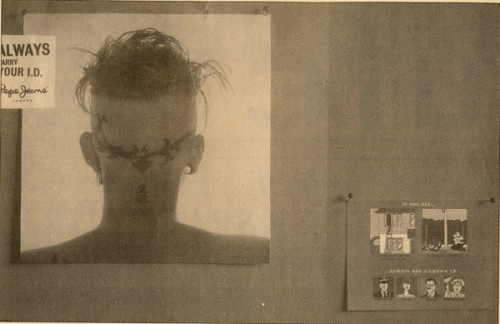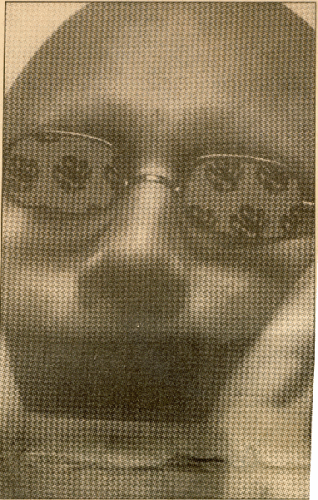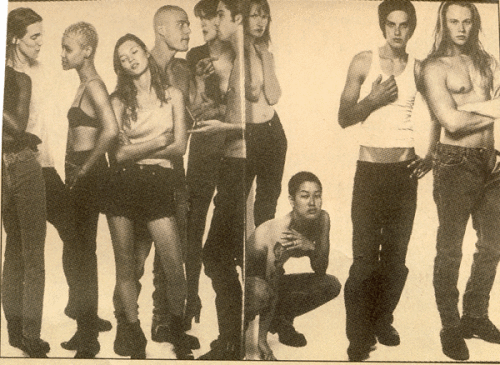Rages of the Pop Market
In the early 90's, I interviewed Corinne Day for the German photography magazine, Profi Foto. Day's photographs in The Face, I-D and British Vogue became emblematic of the grunge label, marked by wasted, strung-out teenagers. Day became a celebrity herself, launching the career of Kate Moss and finding herself at the centre of moral debates, not least the rise of anorexia nervosa in teenage girls. Her intention was to dispel with the material glamour circulating in the 80's and show what it was really like to be an adolescent, a Generation X-er. "People can't deal with seeing reality," she said. " It's interesting when people hate the pictures taken during their adolescence because they can't relate to being a teenager."
Mid 90's, gritty realism's remnants and its lost teenagers have finally filtered through to mainstream advertising, for example Calvin Klein's perfume, CKI campaign. But there are a barrage of articles decoding this near-dead style which take a moral stance. One featured in the Independent drew a sharp line between advertising and editorial photography. Corinne Day's 'original' fashion imagery was seemingly being ripped off by the large corporate advertisers. The bottom line concluded that advertisers should shoulder some responsibility in their portrayal of youths. This type of 'decoding' currently favoured by the media runs parallel to sensationalist reports on increased drug use amongst 14 year olds upwards. Counter culture, the media seem to suggest, the one-time domain of fringe sub cultures and its outlaw members has punctured the mainstream to become central to I new' youth culture. When one of the founders of "The Herb Garden", an 'alternative' British fanzine for "boozers, users and losers" wrote a strident attack in The Guardian which criticised the "dull, patronising and potentially dangerous" approach to drug reporting, the published article was watered down to that of the tired ramblings of a family man living on a council estate (Guardian, July 1995).

This message presupposes a number of myths on the part of the consumer. Firstly, that magazine consumers separate advertising and editorial photography, deciphering only advertising campaigns as 'the sell'. Editorial spreads are thus somehow removed from the mechanics of desire and consumption. The idea of the consumer as the eternal passive dope still prevails. Another myth presupposes that photographers creating the trends are purist innovators. In fact photographers Corinne Day and David Sims have done their own bit of borrowing from fine art photographers such as Larry Clark and Nan Goldin.
I want to address our passive dope and look at several types of mid-nineties iconography, no longer one set movement in consumer culture and explore the relationship between the need to constantly create the brand new and new technology.
Images intensively manage our identities, presenting our multiple selves through consumption. This is increasingly evident in the current tide of media-literate consumers. Identities can be bought. Youth generation is harder to define and harder to reach not because of the increasing battle for new products crowding shelf space, rather because youth itself is up for grabs. Muriel Grey at a recent MTV conference, for example, kicked off by saying that she didn't want a discussion on the definition of youth culture - it was too complex and meant different things for different markets. But it's evident that the consumer is no passive dope, rather is able to freely pick and choose faced with such a diverse landscape of products. And familiarity for those products comes early. Susie Orbach wrote that kids learn corporate recognition before their 3x table. Kids may be too young to see a movie, but they can still buy the off-spin merchandise from the shop.

Also evident is that current youth advertising is increasingly about the authentic - the product that claims a space in the lived world - that stretches beyond the early 90's in-your-face iconography of gritty realism. One of advertising's focal points seems centred around the snapshot, the frozen slice of family life. Traditionally, snapshots were stuck into the family album, hidden behind thick covers, looked at as a leisure pursuit. However now they are scattered around the house and spliced with other bits making up everyday experiences - haphazardly stuck onto the fridge alongside memos, lists, drawings; propped up on bookshelves with clippings; taped to the wall with posters of pop heroes or football teams. They become icons. Larry Clark photographed collages of snapshots and clippings stuck on his walls for his book "the Perfect Childhood", which suggested to New York critic Andy Grundberg that the "self confessional mode" was in fashion (New York Times, 1990). People reveal their intimate snapshots in domestic space not to capture a memory of 'the time when...', but rather to activate their presentation, how they appear at that moment. Photographs do not act as souvenirs of lived memories, rather they act out a present state of play. Advertising imagery seems to reflect this trend. Always concerned with offering a way to the consumer of presenting the self, it uses the snapshot as an icon. The campaign that uses the snapshot immediately addresses the moment, the fragment of 'now'. Through the use of the snapshot, it can intimately address and reaffirm the collections of snapshots circulating in the home. Incidentally the domestic space has long been proven to be the most effective selling environment. "Confessional mode" dips into advertising - the image authenticates the product, claiming a real life beyond its value as a potential purchase. Witness Pepe Jeans' campaigns and their collages, logos and statements around individuality. The logo "kids'll love 'em" splashed alongside a plastic-wrapped dead frog from the biology lesson captures "Young Ones" - style school as an archaic institution. It talks to the 1624 year old Pepe audience about another, younger 'kids' sector and casually reminds them that we're all in the same tribe. Self-presentation at its most effective.

Teenagers' bedrooms now see ripped out adverts from magazines pinned alongside pop heroes. The adverts themselves have an iconic status beyond it representing the product. The image used to represent the product and sell an idea. Nick Kamen's appearance kick-started the tremendously successful Levi campaigns some 10 years ago, launching his career. Fans would stick his pin-up on walls or school books, now the difference is that the ad gets cut out and shown. The image takes on a more sophisticated role that used to be the sole preserve of the product.
Digital communications offer more ways of "being there", cutting across time and space to bring large groups of people together. Britvic Ltd. have introduced an on-line service and a successful telephone line which has currently received 2 million calls from Tango fans. The product provides multiple channels available for consumers to connect. The product and its offers become woven into everyday teen life. The message: Tango will always be there. Media-savvy consumers know it's a sell, but what the hell? It's entertainment. Britvic have also introduced the Tango orange doll, now a familiar sighting in dance clubs, not least in a Leicester haunt where ravers, according to Mary Sweeting, the company's Press Officer, shout "Go Tango Go" to the orange doll imprisoned in a hanging cage amidst laser lights and dance music, hoping for the Tango effect as seen on tv.

With the brave, new world promised and fetishized by new technology. there's a tendency to unhinge digital imagery from a climate where the dominant message is a prevailing cultural pessimism - disillusionment with older values, the nuclear family, politics, long-term job security. Parallel to this runs the myth of a utopian future as we approach the millennium, that technology will allow/force us to radically break from the past and the future will be unrecognisable from the past and present. When the Youth magazine "G Spot" launched, it was with the declaration that the magazine was the voice for a new generation. Cutting through the marketing hype, is there a claim for a 'new' generation home-grown on new technological developments? It depends what the I new' means. Certainly, this is the first generation fed on a diet of computer games, computers in schools and aware of virtual spaces and realities. A logical reason why "G Spot" soon fastened onto gameboy culture and steadily flavoured its content with digitalia. But the way that New Technology is diffused into markets is by hanging New Technology onto the familiar signs and symbols accumulated by photographic history. Everything refers back to older times, rehashing older generations. Fashion spreads may declare the current season as "minimalist, not retro", but it is borrowing a name of an older game. Culture is spurting out a scrambled new/old, the only difference is the new/old is now accelerating at a faster rate. Advertising embodies this new/old style by appropriating the 'new' images to suggest the simulated. It relies on consumers understanding advertising's mechanics. The latest album release of Jimi Hendrix's music, the "digitally remastered" experience, is sold as superior to the known and live Hendrix because it's new, it's been produced by New technology. Hendrix lives on, but lives on better than before. The past is only relevant in terms of presenting the new as "better than". A gold embossed hyper-Hendrix appears on the album cover. After all, he's dead, so he can't look as if he's walking around. He exists on the computer, his music is in the computer and it's Better than Before. The image of Canadian Richie Hautin from the band, Plastikman is a computer logo. Zipping up his mouth, computer animated icons over shades, his personae is an artificial signature. The image is associated with the new, suggesting the brand of Plastikman's music but it relies on an understanding that tried and tested album covers carry public personas and that the newness associated to Plastikman hangs onto the new sound of the band.
Finally, McDonald's' latest tv campaign recounts an older man in the future reflecting back on his current childhood. Mainstream `soft' techno-culture is seen with the boy's visit to the simulator game and scenes are freeze-framed in McDonald's to suggest some snaps taken in the restaurant for the family album. These snaps look as if they have been digitally retouched to suggest the past - the colour red is reminiscent of a 60's old Pepsi commercial - the cheesy-framed, slightly stagnant smiles remind us of old family snaps and the time spent waiting front to the lens. But even if the images weren't retouched, it doesn't matter. What's important is the past, present and future. The use of the technology in the advert is fetishized from the visited game through to the colours in the snaps, implying that photography (in the future) is a dated family craft. I would conclude that digital imagery and associations with new technology are filtering across advertising. It's a powerful tool to suggest the new, the authentic and is able to offer intensive channels of communication and increasingly become seamlessly woven into our everyday live. But however 'new' the technologies appear, imagery can never be Brand New, it can only represent ,new'. Otherwise it wouldn't hang on to the familiar, and would sever itself from the recognition required for consumers to both present and buy into their identities. That familiarity is fundamentally dependent on photography and the codes it has accumulated in its still relatively short history.
(from Agents of Change, 5th National Conference of Photography, September, 95)
Mute Books Orders
For Mute Books distribution contact Anagram Books
contact@anagrambooks.com
For online purchases visit anagrambooks.com






